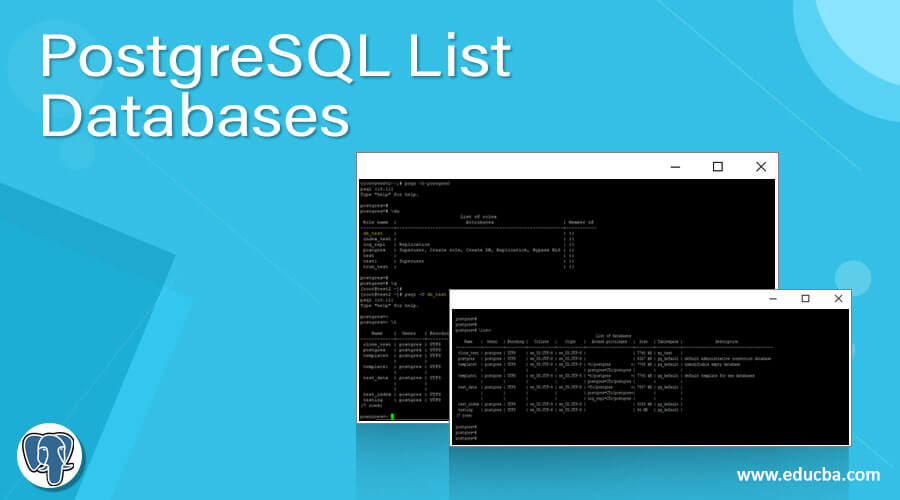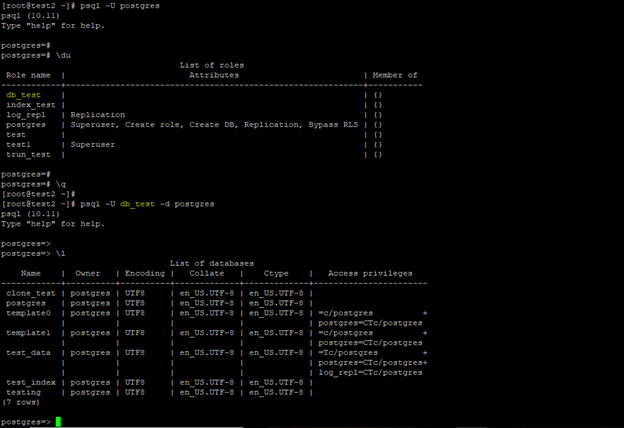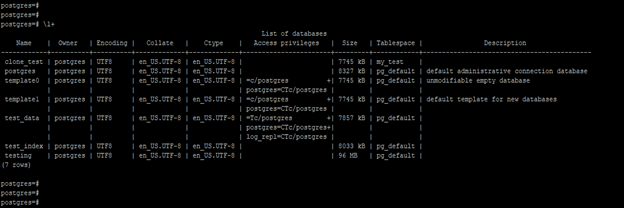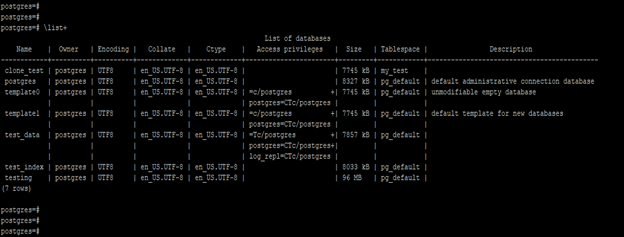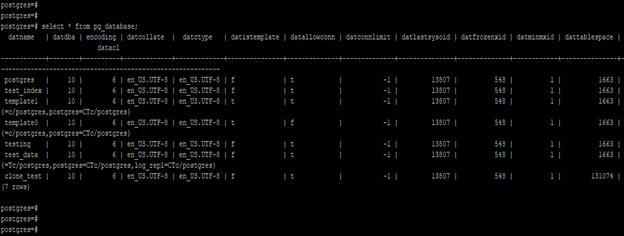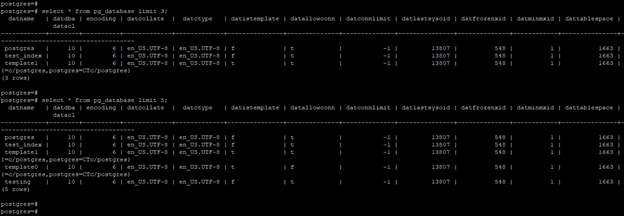Updated May 22, 2023
Introduction to PostgreSQL List Databases
PostgreSQL list databases list all the databases from the database server; we can list the database using the pg_database catalog table. We can also see the list of the databases by using the \l command; The PostgreSQL l+ tool allows us to view more database descriptions. To list the database in PostgreSQL is very important and useful to see all created databases on the PostgreSQL server. To see a list of databases in PostgreSQL, we need to connect to the database through psql; we can also see the database using shell prompt.
Syntax
- \l
- \l+
- \list
- \list+
- Select name_of_column1, name_of_column2, name_of_column3, …, name_of_columnN from pg_database (name_of_table);
Below is the parameter description syntax of list databases in PostgreSQL.
- \l –This command lists all databases with information on the database name, database owner, encoding, collate, ctype, and database access privileges.
- \l+ – This command is used to list all databases with information on the database name, owner of the database, encoding, collate, ctype, and access privileges of the database, size of the database, database tablespace name, and description for the database.
- \list –This command is the same work as the \l command in PostgreSQL. This command is used to list all databases with information on the database name, owner of the database, encoding, collate, ctype, and access privileges of the database.
- \list+ – This command is the same work as \l+ command in PostgreSQL. This command is used to list all databases with information on the database name, owner of the database, encoding, collate, ctype, and access privileges of the database, size of the database, database tablespace name, description for the database, encoding, collate, ctype and access privileges for the databases.
- Select –This operation selects a column from the pg_database table to list the databases. We can select specific or all columns from the table to see the list of databases in PostgreSQL.
- Name of the column –This is defined as the column’s name for the table of pg_database. We can select a single or all columns we want to display in the output.
- Pg_database –This is a catalog table of PostgreSQL that contains the information of all the databases created by the user and contains the information of system databases.
How to list databases in PostgreSQL?
- We can list the databases as follows.
- To list the databases in PostgreSQL, we do not need to provide any privileges to the user; any user can list the databases in PostgreSQL.
- The below example shows that we do not need to provide any privilege to list databases for users in PostgreSQL.
- In the first example above, we checked the user’s privileges; the db_test user has no rights on the database server.
- In the second example, we use the db_test user to list databases; using the db_test user, it’s possible to list the databases in PostgreSQL because we do not need to be given any privileges to list the databases in PostgreSQL.
psql -U postgres
\du
psql -U db_test -d postgres
\l- We have used the below command to list all the databases as follows.
- \l
- \l+
- \list
- \list+
- Select * from pg_database;
- We can use the metadata command and pg_database catalog table to list the databases in PostgreSQL.
- Using the above command, we have a list system and user-created databases.
- We can list the database by using the shell prompt and the database shell prompt in PostgreSQL.
- We can also use limited options to list the database using the pg_database catalog table. The pg_database catalog table is very important for fetching the information related to all the databases.
Examples
Below is an example of a list of the databases.
1. List the databases by using \l command
The below example shows that list the databases by using \l command.
\l2. List the databases by using the \l+ command
The example below shows that list of the databases using the \l+ command.
\l+3. List the databases by using the \list command
The example below shows database lists using the \list command.
\list4. List the databases by using \list+ command
The below example shows that lists the databases by using \list+ command.
\list+5. List the databases by using the shell prompt
The below example shows that lists the databases by using a shell prompt. In the below example, we have listed all the databases using the shell prompt command as \l+.
psql -U postgres -d postgres -c "\l+"6. List the databases by using the pg_database catalog table
The example below shows that list of the databases using the pg_database catalog table.
select * from pg_database;7. List the specific number of databases by using limit
The example below shows that lists the specific number of databases using limits.
select * from pg_database limit 3;
select * from pg_database limit 5;8. Display only a list of the database name
The example below shows only a list of database names on the server.
select datname from pg_database;Recommended Articles
We hope that this EDUCBA information on “PostgreSQL List Databases” was beneficial to you. You can view EDUCBA’s recommended articles for more information.

